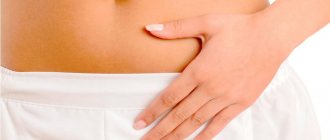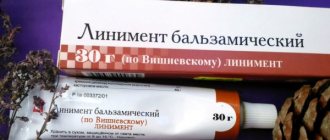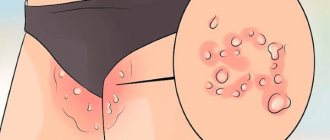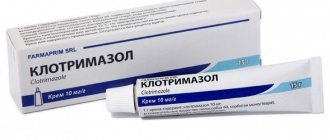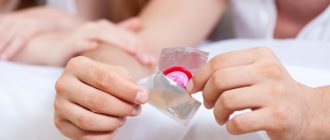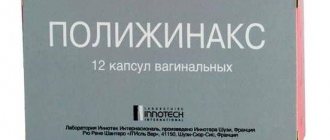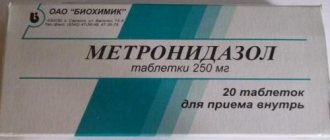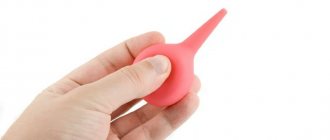Ichthyol ointment is an anti-inflammatory, antiseptic, analgesic for external use. Used in the treatment of dermatological and gynecological diseases, if necessary, to relieve inflammatory processes in arthritis. It is applied to the pathological lesion in a thin and at the same time dense layer; a bandage is required. The “compress” is kept for 4-12 hours, the duration of therapy usually does not exceed 14 days.
The cost of Ichthyol ointment ranges from 95-125 rubles.
Main characteristics of Ichthyol ointment
Ichthyol ointment is an external antiseptic agent that began to be actively used in medicine at the end of the 19th century.
| Characteristic | Brief Explanation |
| Release forms | Ointment for external use, rectal suppositories |
| Concentration of the main active ingredient | For the treatment of people – 10%, in veterinary practice – 20% |
| Basic steps | Anti-inflammatory, antiseptic, analgesic |
| When to use | Skin diseases, some joint pathologies, gynecological diseases |
| Terms of sale | No prescription required for purchase |
| Where to store | Room temperature within 15-25 degrees, avoid direct sunlight on the packaging |
| Best before date | 5 years from date of manufacture |
What is ichthyol
Ichthyol is a substance with a resinous structure that is extracted from shale rocks; in the chemical industry it is called ammonium bituminous sulfate. Ichthyol is extracted from organic resin - it is processed, purified in several stages, distilled and then treated with alkali, sulfuric acid and ammonia water. The last stage is evaporation of the resulting material, which ends with the formation of “pure” ichthyol.
Interestingly, “ichthyol” means “fish” in Greek, and the name stuck because the remains of the skeletons of prehistoric fish are often found in shale rocks.
We recommend reading about the most effective ointments for scars. From the article you will learn about how ointment for scars works, the best ointments for the face, body, after surgery and new generation ointments.
And here is more information about the options for using Salicylic ointment.
Composition, what it is made from
The ointments and rectal suppositories contain the substance from which the drug is actually made - ichthyol (ichthammol) in a concentration of 10 or 20%. The suppositories use vitepsol as an additional component, and the ointment uses medical Vaseline.
Additional components do not have any therapeutic effect, but are necessary to obtain the desired consistency of the preparations. The ointment has a homogeneous structure and a pronounced aroma of ichthammol - it is specific and simply cannot be confused with another smell. Suppositories are dark-colored cylinders pointed at one end.
Reviews on the use of liniment in gynecology
Indeed, this budget product with an unflattering appearance and specific aroma can help solve many diseases of the female genital area. In order to verify this once again, let's look at reviews of tampons with Vishnevsky ointment in gynecology.
Yulia Starikhova, 34 years old, Moscow
“The doctor prescribed treatment with Vishnevsky ointment when diagnosing inflammation of the right ovary. I used homemade tampons soaked in ointment for 10 days (at night). The treatment was effective - the inflammation went away, and as an additional bonus, the recurrent thrush also went away. That’s for sure: everything new is well forgotten old. I didn’t even know that women’s diseases could be overcome in such a simple way. But it works!”
Marina Belova, 28 years old, Tyumen
“I have a blocked tube. I was admitted to the hospital with inflammation. A wonderful doctor prescribed me tampons with Vishnevsky balm for 14 days (start after menstruation, if possible), then a break of 14 days, after menstruation another 14 days of treatment. He said that it can be repeated if there is an exacerbation. I was treated for 2 cycles. Everything is over. So far there have been no exacerbations. »
Veronika Efremova, 32 years old, St. Petersburg
“For the last three years I have been experiencing severe pain during menstruation. A cyst of the right ovary was discovered. I read on the forum that girls treated polycystic disease with tampons with Vishnevsky ointment. I started treatment at my own risk. After the third, I suddenly noticed that a large amount of some gray blood had come out on my underwear. I got scared and ran to the doctor. After the examination, it turned out that it was the same cyst that burst under the influence of liniment. I'm happy with the result."
Yana Zadorozhnaya, 30 years old, Voronezh
“I have been actively being treated for endometritis and endocervicitis for the third year now. Antibiotics are endless, dysbiosis in the vagina has begun to such an extent that life has simply become unpleasant. I changed several doctors until, finally, a friend recommended a good specialist. Imagine my surprise when he prescribed me (in addition to the main treatment) to put tampons with Vishnevsky balm at night (10 days). It became easier after the third use. So far so good. I hope the disease will not return again.”
Olga Zhukovskaya, 24 years old, Smolensk
“If I have a cold like a woman, Vishnevsky’s balm saves me. Grandmother suggested from her experience. Now I am one of those who were helped by such executions. I just insert a regular tampon with ointment before going to bed. In the morning I take it out and wash it thoroughly. I repeat this 5-6 times. And everything is OK. The smell is, of course, terrifying, but the effect is super!”
What does ichthyol ointment help with, properties and action
Ichthyol ointment contains a lot of sulfur (due to ichthammol), so it helps with inflammatory, infectious diseases, purulent abscesses and wound healing. The product has pronounced antiseptic, analgesic, and anti-inflammatory effects. Keratoplastic properties ensure softening and resorption of infiltrates, drying of tissues, acceleration of regenerative processes at the cellular level.
Indications for use in humans
Indications for use of Ichthyol ointment in humans:
- various dermatological diseases: erysipelas, purulent inflammation of the sweat glands of the armpits, various types of dermatitis, lupus erythematosus, inflammation of the hair follicle, pyoderma, boils/carbuncles, rosacea and others;
- as one of the drugs in the complex therapy of neuralgia and arthritis;
- gynecological pathologies – colpitis, adnexitis, vaginosis, cervicitis;
- prostatitis of various origins (inflammation of the prostate gland in men);
- haemorrhoids.
What does it help for animals?
For animals, a more concentrated ichthyol ointment (20%) is used, it helps against:
- inflammatory skin diseases - eczema, wounds of various origins (including burns, lacerations), dermatitis;
- hoof/hooves diseases;
- furunculosis;
- any pustular lesions.
Contraindications
There are practically no contraindications to the use of the drug. Its use is not recommended only in case of individual intolerance or hypersensitivity to the main active ingredient ichthammol. In this case, we are talking about an allergy to ointments and suppositories.
How to make tampons with Vishnevsky ointment correctly?
To treat gynecological ailments with ointment, you will need the ointment itself and a tampon (from a pharmacy or made yourself). A tampon is soaked in the product and inserted deep into the vagina overnight. One application may require 12-15 g. In the morning, the tampon is removed and douched with chamomile decoction.
During treatment, you may notice that a certain amount of unusual discharge of various shades comes out, sometimes mixed with pus (maybe even blood comes out). This indicates the effectiveness of the product and its powerful cleansing and restorative processes occurring in the depths of the reproductive system.
Ichthyol ointment: instructions for use
Instructions for use indicate external use of Ichthyol ointment - it is used to lubricate pathological lesions and apply compresses. The ointment can be placed in the rectum or vagina, but in the latter case, severe irritation of the mucous membrane may occur, which is manifested by itching and burning.
External use for skin diseases, arthritis and neuralgia involves applying a layer of ointment so that the skin does not show through it; there is no need to rub the drug in. A gauze bandage is applied on top. 2-3 treatments of the pathological focus should be carried out per day, the average duration of therapy is 10-20 days. Ichthyol ointment is applied only to a clean surface, so before each manipulation the area should be washed with warm water and soap and dried.
Application of Ichthyol ointment for acne
To treat pelvic inflammatory diseases, the ointment is placed into the rectum or vagina using a tampon - made from cotton wool or using a standard hygienic one. Place 15 g of the drug (about 1 teaspoon) on a tampon; when inserted into the rectum, you should first empty your bowels or do a cleansing enema.
Tampons are changed every 10-12 hours (manipulations are carried out 2 times a day), the total duration of treatment is 10-14 days.
In any case, it will be possible to re-therapy with Ichthyol ointment, but only after a break of 10-15 days.
Suppositories are used as standard: they are placed in the vagina or rectum 2 times a day with a break of 10-12 hours. It is important to push the candle completely so that after it dissolves, the medicinal substance does not leak out. In case of irritation of the vaginal mucosa, it is recommended to use suppositories rectally - the therapeutic effect will be provided with constant intensity.
For external use for abscesses, pus
Ichthyol ointment is suitable for external use for abscesses and for getting rid of pus due to its keratoplasty properties. When this drug is applied to a pathological focus, the process of formation of a “head” in the abscess is accelerated, the contents of the abscess rise to the upper layers of the skin.
“Ichthyolka” also promotes the rapid opening of the abscess, which automatically leads to the expiration of the contents. As a result, a clean wound surface is formed at the site of the abscess - it is washed with an antiseptic solution such as Miramistin, Chlorhexidine, and an ichthammol-based ointment is applied again. Now the drug will “show” its wound-healing properties - regeneration will go faster, the wound will heal.
For any abscesses, ulcers (including boils/carbuncles), ichthyol ointment is applied “pointwise” in a layer of 0.5-1 cm. A sterile gauze napkin is placed on top, everything is fixed with an adhesive plaster. The dressings need to be changed every 8-10 hours until the abscess breaks and its contents pour out.
For acne, blackheads
Ichthyol ointment for acne and blackheads helps due to its anti-inflammatory and keratoplasty properties. The drug literally “dissolves” the fatty secretion and brings it out. The nuances of using ointment for acne:
- applied “pointwise”;
- suitable for treating “deep” acne;
- the drug is applied directly to the pimple;
- the “holding” time of the drug on the pathological focus is 1-2 hours;
- after the pus comes out, you need to rinse the area with Chlorhexidine or Miramistin.
The use of Ichthyol ointment for acne allows you to avoid the formation of scars, which are typical for mechanical removal of the lesion (squeezing).
As for blackheads, the “ichthyol” against them should also be applied pointwise, but if the problem is located on the nose, then the ointment is applied in a thin layer over the entire surface of this part of the face. After 1-2 hours, the remnants of the drug are washed off with warm water, you can wipe the cleaned areas with lotion without alcohol in the composition.
Watch this video about the use of Ichthyol ointment for acne and blackheads:
Will it help with wen?
Ichthyol ointment does not treat wen, does not promote their removal or resorption, but this drug can be used in complex therapy. It is necessary after laser correction or radio wave removal of the wen to prevent the development of the inflammatory process.
Apply a thin layer of ointment directly to the place where the wen was removed. The dressing time is 2-4 hours, the manipulation is repeated 2 times a day.
In gynecology
In gynecology, “ichthyol” is never used in its pure form - it causes severe irritation of the mucous membranes, which can worsen the overall clinical picture of the disease. To prepare the medicinal composition, Ichthyol ointment is diluted with medical glycerin in equal proportions; the additional component can be replaced with camphor oil. Both substances reduce the concentration of the main active ingredient, but this does not detract from the medicinal properties of the drug.
Often, when treating gynecological diseases, doctors prescribe the introduction of Ichthyol ointment into the rectum - the active substances will enter the bloodstream and will be transported with it to the pelvis, to the inflamed organs.
It is strictly forbidden to use ichthammol-based ointment for diagnosed cervical erosion, because such treatment will increase irritation of the wound surface of the organ and can lead to bleeding.
If glycerin is used as an additional component of the treatment mixture, then the woman should be prepared for copious mucous discharge from the vagina. This is a normal phenomenon, so the microflora will be cleared of pathogenic microorganisms.
In gynecology, tampons are made from cotton wool or ready-made hygienic ones are used. Approximately 15 g of the drug (about 1 incomplete teaspoon) should be applied to one; the time the tampon remains in the body is about 8 hours. You can do 1-2 manipulations per day, the course of treatment is on average 10 days.
For hidradenitis
With hidradenitis (“bitch udder”), a lump forms in the armpit, which indicates inflammation of the sweat gland. Strepto- or staphylococci are found in the contents of this formation, so it will be necessary to carry out complex therapy using broad-spectrum antibiotics.
Acute purulent inflammation of the sweat gland can be cured with Ichthyol ointment - a bandage with it is applied to the pathological focus 2 times a day. It is changed every 10-12 hours, and before manipulation, be sure to wipe the lump with antiseptic solutions - Chlorhexidine, Miramistin, diluted with medical alcohol.
Watch this video about the treatment of hidradenitis with Ichthyol ointment:
For burns, wounds
The drug has powerful wound-healing properties, which allows it to be used for burns, cut/puncture/lacerated wounds. In this case, the ointment “works” both as an antiseptic and as an anti-inflammatory agent and allows you to replace the use of two with different abilities. For example, if “ichthyol” is used in therapy, then it will be possible to refuse to wash the wound with Chlorhexidine and apply compresses with Solcoseryl.
Ichthyol ointment is applied to the wound surface in a dense, but not thick layer. A sterile gauze napkin is applied on top, and if necessary, everything is fixed with an adhesive plaster. Dressings are done every 8-10 hours until the tissues are completely healed.
Arnica ointment for congestion
Ichthyol ointment is an antiseptic and disinfectant that effectively eliminates infection from the skin surface. It is used in gynecology, urology and various skin diseases.
Ichthyol ointment is an external agent that has a dark brown or black color with a pronounced tar smell. It is simply irreplaceable for various types of purulent processes; here ichthyol ointment is most often used.
As a rule, the indications for the use of this ointment are the treatment of various dermatological problems, that is, those related to the skin, for example, ichthyol ointment for acne is excellent. Diseases such as, for example, burns, frostbite or all kinds of skin rashes (eczema, furunculosis, etc.) are also treated with ichthyol ointment.
In gynecology it is used for inflammatory processes (for example, mastitis), where it can neutralize inflammation of the fallopian tubes and ovaries, cure the uterine mucosa and much more. When you study the instructions for ichthyol ointment, you will find out that it even has the ability to pull splinters out of the skin and treat inflammatory processes that occur in the joints.
According to reviews, Ichthyol ointment exhibits an anti-inflammatory and analgesic effect on the deep layers of soft tissue a few hours after application.
Ichthyol ointment is indicated for the treatment of inflammatory diseases of the pelvis (oophoritis, salpingitis, parametritis, etc.)
Analogues of Ichthyol ointment
Analogues of Ichthyol ointment include:
- Antisept 70% or 90%;
- balsamic liniment according to Vishnevsky;
- Sodium tetraborate;
- Septol;
- Chlorophyllipt;
- Fitoval;
- liquid indicin.
Antisept 70%
Balsamic liniment according to Vishnevsky
Sodium tetraborate
The listed drugs are identical in action, but only “ichthyolka” is capable of providing a complex therapeutic effect and not only stopping inflammatory processes, but also quickly eliminating purulent contents from the formed cavities.
Specifics of using tampons and ointments
To treat gynecological diseases, you can buy a ready-made product, mainly made in China, or make it yourself. Doctors insist that it is better to make a tampon yourself at home, because this is the only way to be sure that the product is absolutely safe and effective.
Making a tampon for introducing ointments or medicinal solutions into the vagina is quite simple. You need to cut a small piece of bandage and wrap it around your index finger in several layers, but you can also use another item of a similar shape. The edge of the bandage that will stick out from above needs to be folded into the middle and rolled over another layer. The wrapped bandage should be removed from the finger, a small piece of cotton wool should be inserted into it, onto which the ointment is applied, and then the entire tampon is coated with the medicine. If the drug is used in the form of a solution, you need to dip the entire tampon into it and squeeze it out a little. A more hygienic method of administration is to use an ordinary pharmaceutical product.
Vishnevsky ointment
Balsamic liniment is used to treat the following gynecological ailments:
- inflammatory diseases of the appendages;
- infertility due to obstruction of the fallopian tubes;
- cervical erosion;
- candidiasis;
- pathological processes in organs located in the pelvis.
Tampons with Vishnevsky ointment are used to quickly restore the genitourinary system after surgery, which gives the following effect:
- destruction of pathogenic infectious microflora;
- activation of the regeneration process at the cellular level, which accelerates the healing of the mucous membrane;
- the state of microflora in the vagina is normalized.
Vishnevsky's balm is often used for adhesions, which block the passage of the fallopian tubes and cause infertility.
Interaction with other drugs
Ichthyol ointment is not recommended for use simultaneously with other antiseptic external agents such as iodine and preparations containing alkaloids and heavy metal salts. This combination can cause severe skin irritation, even deep burns.
All preparations for internal use, as well as for intramuscular/intravenous injections, are absolutely compatible with ichthammol-based ointment.
We recommend reading about the best ointment for acne. From the article you will learn about the most effective ointments for acne, medications for inflammation with antibiotics, and indications for the use of hormonal medications for acne.
And here is more information about what ointment to use for psoriasis in children and adults.
Ichthyol ointment is considered one of the most effective drugs in the treatment of inflammatory and infectious pathologies on the skin, as well as some diseases of internal organs. It is used in short courses, significantly speeds up the healing and regeneration processes, and practically after the first use it stops inflammation and promotes the removal of purulent contents.
Therapeutic tampons with ointment: 8 options
Therapeutic tampons with ointment are an effective way to treat a number of gynecological diseases of an inflammatory and infectious nature. Local use of ointments promotes rapid absorption of the active components of drugs into the mucous membranes. Despite the fact that vaginal tampons with ointments are an effective remedy, using them on your own is not recommended. With long-term therapy, it gradually loses its positive properties.
